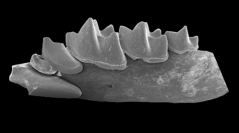

 Comptes Rendus Palevol
8 (1) - Pages 21-37
Comptes Rendus Palevol
8 (1) - Pages 21-37This paper reports the first paleontological record of Beremendia fissidens (Mammalia, Soricidae) in the Iberian Peninsula during the second third of the Early Pleistocene. The species is exclusively present at the lowermost levels (Lower Red Unit: TE8–14) of the Sima del Elefante site, one of the largest stratigraphic sections of the Atapuerca cave complex (Burgos, Spain). The age of Sima del Elefante shows that this large-sized type of red-toothed venomous shrew inhabited the Sierra de Atapuerca more than 1.1 Myr ago, coexisting with an extremely rich and diverse faunal association of nearly 40 small and large mammalian species, including hominines. The presence of this species in the Atapuerca locality has important palaeoecological, palaeobiogeographical and biostratigraphic implications, which are extensively discussed here, throwing light on aspects largely left aside for this important group of red-toothed shrews, previously relegated to nothing but mere faunal lists, at least in the Iberian Peninsular context.
Soricine, Systematic palaeontology, Palaeoecology, Palaeobiogeography, Atapuerca, Sima del Elefante, Spain